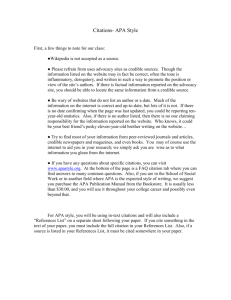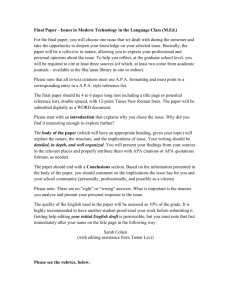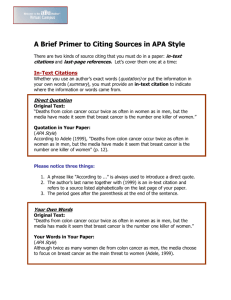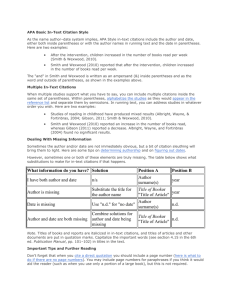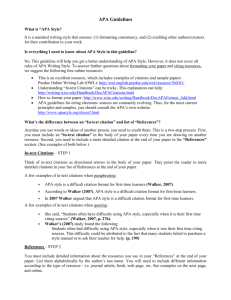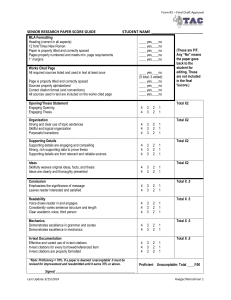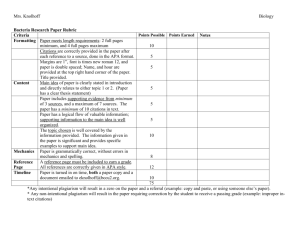In-Text Citations
advertisement
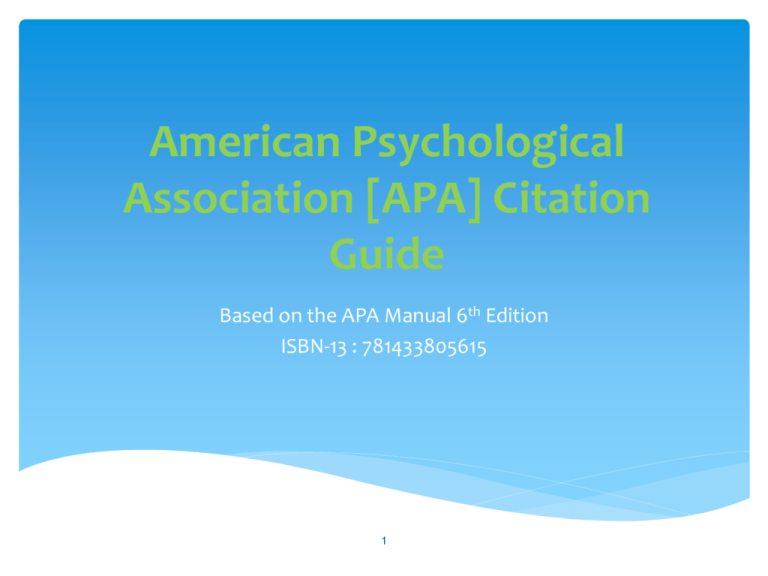
American Psychological Association [APA] Citation Guide Based on the APA Manual 6th Edition ISBN-13 : 781433805615 1 Table of Contents Paper Format Slides 4-10 In-Text Citations Slides 11-42 References Slides 43-85 2 APA Websites American Psychological Association. (2010). Publication manual of the American Psychological Association (6th ed.). Washington, DC: Author. The OWL at Purdue. (2012). APA formatting and style guide. Retrieved from Purdue University: http://owl.english.purdue.edu/owl/resource/560/01/ The Writing Center @ The University of Wisconsin-Madison. (2011). APA documentation guide. Retrieved from http://www.wisc.edu/ writing/Handbook/DocAPA.html 3 Formatting a Scholarly Paper Part 1 4 Format: Basics Font: Times New Roman, 12 point. 2 spaces after periods. Margins, 1.0” all around. Jagged right-edge text alignment: Do not justify. Left margin can be l.5 inches if instructor has requested the paper to be bound. Everything is double-spaced, including quotes and reference page. 5 Format: Spelling and Word Usage To ensure compliance with APA style requirements, use the current Merriam-Webster’s Collegiate Dictionary as a default for spelling words. The dictionary can also be used as a resource for hyphenation, capitalization, etc. 6 Format: Title Page Include author’s name (byline) and institutional affiliation. Author’s name should include full first name, middle initial, and last name. Affiliation identifies the location where the author, or authors, conducted the investigation. If there is no institutional affiliation, list the city and state of the author’s residency below the author’s name. For GCU students the affiliation should be Grand Canyon University followed by the course prefix and number. 7 Format: Title Page Page numbers start with title page by setting header feature in your software. Page number is flush right. Running heads should include several words from title. For specific guidelines on formatting running heads, refer to the APA Manual (2010), pp. 229-230. See example of a title page in APA Manual (2010), p. 41. 8 In-Text Citations Part 2 11 In-Text Citations When you use material from a source, you need to document that source. All quotations, paraphrases, and summaries must be cited in text. Using material from a source without citing that source is considered plagiarism; please reference GCU’s policy on plagiarism in the University Policy Handbook. 12 In-Text Citations Two things to remember above all: If an entry appears in text, it must have a corresponding entry in the Reference list unless it is a “personal communication” or a “major classical work.” Similarly, if an item appears in the References, then it must be cited somewhere in text. Enough information must be given in text for the reader to locate the item on the Reference list without difficulty. 13 In-Text Citations Authority Accountability Reasonableness Credibility Trustworthiness Integrity Confidence AARCTIC 14 In-Text Citations Purpose: In-text citations give the author the AARCTIC without the frostbite of plagiarism. Consequently, any borrowed information, whether quoted directly, summarized, or paraphrased must exhibit a clear indication of its origin. 15 In-Text Citations Include as much of the following information in a citation within the body of a paper as possible: Author Absence of an author allows the use of a truncated version of the source document’s title. Copyright Year Location within the source document (e.g., page, paragraph, or section number). Summaries and paraphrases do not necessarily require the location element, but it is not wrong to include it. Standard in-text citation: (Author’s last name, year, p. #) 16 In-Text Citations: Authors General Rules: An author mentioned within the body of a sentence can include a first name, if desired. Only surnames are represented in a parenthetical citation. If two or more authors share the surname, then use first and middle initials to differentiate them. For example: Sentence body: A. B. Smith (2004) contradicted C. D. Smith (2006) when she said… Parenthetical: (Smith, A. B., 2004) (Smith, C. D., 2006). (Note: inverted name order and the space between the initials.) 17 In-Text Citations: Authors One or two authors: Always use the surnames of both authors throughout the paper. Always cite authors in the order they appear on the source material. Multiple author punctuation: Authors of a source mentioned within a sentence use the word “and.” Authors represented in the parenthetical use the ampersand (&) (APA, 2010, p. 175). 18 In-Text Citations: Authors Three to five authors: Cite all authors the first time a reference occurs within an entire paper; subsequent citations require only the surname of the first author followed by “et al.” (Note: there is no period following the “et” but there is a period after the “al.”) 19 In-Text Citations: Authors Six or more authors: Cite only the surname of the first author followed by “et al.” (Note: There is no period following the “et” but there is a period after the “al.”) No author Use a few words of the item’s title or the entire title (if it is short) in place of the author. Use quotation marks (for article) or italics (for book) around the title identifier. 20 In-Text Citations: Authors Groups as authors. Corporations, associations, government agencies, study groups, etc. Usually spelled out each time they are used in-text. Remember: The key is to be absolutely sure that the reader can match an in-text citation to its entry in the reference list. 21 In-Text Citations: Authors Groups as authors, continued. Familiar or readily-understandable acronyms and abbreviations can be used in the second and subsequent citations, but it must be established as follows: First text citation: (National Institute of Mental Health [NIMH], 1999). (Note: The use of brackets avoids nested parentheses.) The National Institute of Mental Health (NIMH) was founded… Note: The use of parentheses to establish the acronym when not nested within a set of parentheses. Subsequent citations: (NIMH, 1999). 22 In-Text Citations: Authors Anonymous vs. Unknown: Authors are only ever referred to as anonymous when they have chosen to be so. In-text citation will list the author in the parenthetical as Anonymous. Reference list will list the author as Anonymous. An author is unknown when there is no identifying information at all. In-text citation will replace the author designation with one or two words from the title of the work. Reference list will promote the title of the work to the location of the author. 23 In-Text Citations: Dates Placement of the date in a citation is always directly linked to the mention of the author. If the author’s name appears in the signal phrase, follow it immediately by a parenthetical representation of the date. 24 In-Text Citations: Dates Four-digit year is standard. Add alphabetical designation for works by the same author published in the same year. Example: (Johnson, 1991a, 1991b, 1991c). Use “n.d.” for no date. This is only acceptable if no date is represented anywhere on a work, website, etc. Use periods after the n and the d, and do not put a space between the two. 25 In-Text Citations: Page Numbers Provide a location reference (e.g., page numbers, or “part” references) for all direct quotations. There is a space between the location reference designation and its number or title. Notations and Abbreviations: Page: p. Pages: pp. Paragraph: para. 26 In-Text Citations: Examples (Sadler, Fine, & Grace, 1999) (Cheek & Hoa, 1981, p. 332)* (Cheek & Hoa, 1981, pp. 332-333)* (Bow, 2000, para. 1) * Note: There is no comma between the first author and the ampersand when there are only two authors in the citation. 27 In-Text Citations: Personal Communication Includes anything from letters, memos, e-mail, telephone conversations, personal interviews, etc. Because it is nonretrievable data, personal communications do not appear in the References list. They appear in-text only. (Note: Personal communications can be called into question for validity and credibility. Use this type of source sparingly.) 28 In-Text Citations: Personal Communication Provide the initials, the surname, and provide as exact a date as possible. J. Burnitz (personal communication, September 20, 2007) indicated … A recent interview (J. Burnitz, personal communication, September 20, 2007) revealed the reluctance … 29 In-Text Citations: Capitalization Applies to Titles and Headings. Capitalize major words. Conjunctions, articles, and prepositions are not considered major. Capitalize all words of four letters or more. Capitalize both words in a hyphenated compound. Capitalize the first word after a colon or dash. (APA, 2010, p. 101). 30 In-Text Citations: Quotes Definition: A precise, word-for-word, punctuation-for-punctuation, errorfor-error reproduction of source material for use in one’s own work. 31 In-Text Citations: Quotes – Signal Phrases Signal Phrases (It’s only POLITE!) Signal phrases introduce the quote, or provide information relevant to the citation that can then be omitted from the parenthetical insertion. Though the placement and appearance may differ, ALWAYS use a signal phrase to signal a reader about information borrowed from a source. Think of it as avoiding “quote bombing,” or dropping of self-contained, unannounced quotations. 32 In-Text Citations: Signal Phrases Signal phrases may require an in-text citation to be broken apart Standard citation: (Author’s last name, year, p. #). Author in signal phrase: Schwartz (2003) contended, “…” (p. 3). Research (Cummings, 2002) suggested that “…” (para. 2), but there are still conclusions yet to be reached. (Note: A comma is not needed before a quote when a quotation falls seamlessly into the flow of the sentence.) 33 In-Text Citations: Short Quotes Short quotes with fewer than 40 words are incorporated into text and enclosed by double quotation marks. Parenthetical citations appear after the end quotation marks, but before the final punctuation, such as a period or a comma. Citation information not contained within a signal phrase immediately follows the quote after the end double quotation marks, no matter where it appears in the sentence. 34 In-Text Citations: Block Quote Used for 40 words or more (APA, 2010, pp. 92, 171). Indent the entire quotation one tab, or the same as an indentation at the beginning of a regular paragraph (half inch). If the block quote incorporates more than one paragraph, indent the first line of the subsequent paragraphs an additional tab (equal to one half inch). Do not use quotation marks at the beginning and end of a block quote. Parenthetical citation appears after the final punctuation mark within the block quote. 35 In-Text Citations: Block Quote Miele (1993) found the following: The “placebo effect,” which had been verified in previous studies disappeared when behaviors were studied in this manner. The behaviors were not exhibited again even when real drugs were given. (p. 40) (Note: The use of double quotes within the block quote is permissible, and the comma appears within the double quotation marks. 36 In-Text Citations: Quotes Altering the appearance of quotations is permissible with the appropriate notation. Errors in the Original text. Because quotations must be an exact duplication of original material, sometimes it is necessary to indicate the legitimacy of the reproduction, such as a special spelling or an error that appears in the original. Insert [sic] immediately after the error appears within the quote. 37 In-Text Citations: Quotes Omission: For an omission of a word or words, use the ellipses (. . .), not 3 periods in a row. If the omission appears in the middle of a sentence, use only the three period ellipses. If the omission appears at the end of a sentence in the quote, use a four-period ellipses to indicate that the final point is the end of the sentence. Do not use ellipses at the very beginning or at the very end of a quotation. 38 In-Text Citations: Quotes Inserting material Use brackets, not parentheses, to enclose inserted material, such as additions or explanations. Adding emphasis If you want to emphasize a word or words anywhere in an APA paper, italicize them. Do not put them in quotations marks or use a bold font. Within a quote, insert the bracketed tag [italics added] immediately after the italicized words. 39 In-Text Citations: Quotes Alterations to quotations that do not require a notation: Making the first letter of the first word in a quotation uppercase or lower case depending on the context. Change ending punctuation to fit the syntax. 40 In-Text Citations: Summaries and Paraphrases Borrowed information that is not reproduced verbatim must be changed significantly in wording and structure when used in-text. It must still be cited using the rules previously mentioned, though a location reference (e.g., page or paragraph number) is not mandatory. Signal phrases are not mandatory for all paraphrases and summaries, but it is still wise to use them. 41 References Part 3 43 References Purpose: References are the map to the AARCTIC. References provide readers the path to directly access any and all source materials used within a document. Bear in mind: Knowing the basics and finding the patterns behind APA citations will make it easier to cope with all of the “exceptions.” 44 References: Must-Haves Elements represented in Reference entries in order of importance: Author Editor Copyright date Title of work directly ascribed to the author Edition Title of “harboring” entity (e.g., magazine, journal name, newspaper, website, etc.) Publication information Publisher information Volume and issue number Page numbers Retrieval address or location (e.g., DOI number, website URL, or housing database) 45 References: Cardinal Rule Remember the Cardinal Rule: References cited in text must appear in the References list; conversely, each entry in the References list must be cited in text. 46 References: Format Begin the reference list on a new page. Using “References” as the title or “Reference” if there is only a single source: Title is center aligned. If the references take up more than one page, do not re-type References on sequential pages, simply continue the list. For each entry, use a hanging indent: The first line is flush left with remaining lines of the reference note indented a half inch. Alphabetize entries by author’s last name. Double space. Use one space after all punctuation. 47 Sample References Page References Elkind, D. (1978). The child's reality: Three developmental themes. New York, NY: Lawrence Erlbaum Associates. Issac, G. (1995). Is solar disorder timed? Adolescents, 30(118), 273-276. 48 References: Authors Single Author Use only a complete surname and the first and middle initials of any author. Surname appears first followed by a comma. First initial – period – space – middle initial – period – space. Multiple Authors Invert the order of the surnames and the initials of all authors. Separate authors from one another with a comma. Use an ampersand (&) before the last author. 49 References: Authors Editor with no author. Place and represent the editor’s name as if it were the author. Immediately follow the name with (Ed.). for a single editor and (Eds.). when there is more than one editor. (Note: The E is capitalized, there is a period after the abbreviation and a period after the closing parentheses.) No author or editor: Promote the title of the piece to main importance. Alphabetize by the first word of the title that is not an article (e.g., the, a, an). 50 References: Authors Same Author Variables Same author, same year Apply an alphabetized designation immediately after the year. Use this identifier in-text, as well. Arrange alphabetically by title. References Jones, J. R. (2001a). Control…. Jones, J. R. (2001b). Roles of …. 51 References: Authors Same Author Variables Same Authors, Different Year of Publication: List by publication date, from earliest to most recent. Jones, J. R. , & Wright, K. (2000). Jones, J. R. , & Wright, K. (2001). 52 References: Publication Dates Give (in parentheses) the year the work was published immediately after the author information. A period belongs after the end parentheses. Standard. (1995). Monthly items. (1995, January). (Note: All months must be completely spelled out. Do not abbreviate.) 53 References: Publication Dates Daily and weekly items. (1995, June 5). Any work accepted for publication, but not yet printed. (in press). Work with no available date. (n.d.). 54 References: Titles Initial Capitalization Capitalize only the first word, the first word after a colon, and proper nouns in titles of books and articles. Agony and you: How to survive really long, dry presentations. Do not capitalize the second word of a hyphenated compound. (APA, 2010, p. 185) 55 References: Titles Do not use quotation marks or underlining as title designators. Use italics for titles of books, newspapers, magazines, and journals. Note: For articles in periodicals, the rules of capitalization and italicizing are split between the title of the article and the title of the periodical: Use special capitalization rules for the actual article, but do not italicize. Italicize the name of the periodical, but use the standard Heading capitalization rules. 56 References: Titles Title components within a reference listing require ending punctuation. Use a period unless there is a specific ending punctuation in the title. 57 References: Editions Book Edition. Edition information appears in parentheses immediately following the title before the period. Use the designation of ed. with a lower-case e and a period. Example: American Psychological Association. (2010). Publication manual of the American Psychological Association (6th ed.). Washington, DC: Author. 58 References: Publication Information Books City of publication – comma – space – state abbreviation – colon – space – name of publisher – period. Example: Newbury Park, CA: Sage. 59 References: Publication Information Periodicals (Journals, Magazines, Newspapers, etc.) Immediately following the title of the periodical, provide a volume number. Include the issue number for journals if, and only if, each issue begins on page 1. Include the range of page numbers of the specific article within the periodical. 60 References: Publication Information Periodical Title (italicized) – comma – space – volume number (italicized) – open parentheses – issue number – close parentheses – comma – space – page range – period. (Note: Do not include any designations or abbreviations, such as vol. for volume number or p. or pp. for page numbers, except where indicated in the APA manual.) Example: Borman, W. C. (2001). Role of supervisor. Journal of Applied Psychology, 78(2), 443-449. 61 References: Publication Information – Electronic Sources Direct readers as closely as possible to the information being cited – whenever possible, reference specific documents rather than home or menu pages. Reasons why it may not be possible to direct the reader to the precise document: The parent website or organization archives its articles after a period of time. The item exists behind a firewall. 62 References: Publication Information – Electronic Sources Electronic publication information comes in the form of a path. In other words “follow this” or “go here” and you will find the source. Digital Object Identifier (DOI): The “path” is in the form of a unique alphanumeric reference number that identifies the specific article. Uniform Resource Locator (URL): The “path” is in the form of a URL, or web address. Note: Do not insert a terminating punctuation mark, or period, after a web address. Do not insert a hyphen if you need to break a URL across lines. Break only after a slash or a period. 63 References: Publication Information – DOI Number If an article has a DOI number, this number should be used to identify access to the article rather than a retrieval URL. Usually, the DOI number is found on the first page of an electronic journal article and/or on the database page providing access to the article. If no DOI number has been assigned to the source you are citing, use a URL to supply the location. 64 References: Publication Information – Internet URL If the an electronic reference has not been assigned a DOI number: Include retrieval information at the end of a reference note in the form of the URL. At the end of the reference note, use “Retrieved from” followed by the URL. Do not put a period after the URL. Do not hyperlink the URL. A date is not required as part of the retrieval information. 65 References: DOI vs. URL Examples Herbst-Damm, K. L., & Kulik, J. A. (2005). Volunteer support, marital status, and the survival times of terminally ill patients. Health Psychology, 24, 225-229. doi:10.1037/02786133.24.2.225 Jones, G. (2001). Role of reference elements. Retrieved from http://jbr.org/article.html 66 Examples APA Reference Notes 67 Sample Reference Note: Authored Book Author, A. A. (Year). Title of work. Location: Publisher. Daresh, J. C. (2004). Beginning the assistant principalship: A practical guide for new school administrators. Thousand Oaks, CA: Corwin. 68 Sample Reference Note: Edited Book Editor, A. A. (Ed.). (Year). Title of work. Location: Publisher. Feldman, P. R. (Ed.). (1997). British women poets of the romantic era. Baltimore, MD: Johns Hopkins University. 69 Sample Reference Note: Electronic Version of a Print Book Electronic Book with DOI: Author, A. A. (Year). Title of work. doi:xxxxxxxxxx Schiraldi, G. R. (2001). The post-traumatic stress disorder sourcebook: A guide to healing, recovery, and growth [Adobe Digital Editions version]. doi:10.1036/0071393722 70 Sample Reference Note: Electronic Version of a Print Book Electronic Book with URL: Author, A. A., & Author, B. B. (Year). Title of work. Retrieved from http://www.xxxxx Shotton, M.A. (1989). Computer addiction? A study of computer dependency [DX Reader version]. Retrieved from http://www.ebookstore.tandf.co.uk/ html/index.asp 71 Sample Reference Note: Electronic-Only Book Author, A. A. (Year). Title of work. Retrieved from http://www.xxxxx O’Keefe, E. (n.d.). Egoism and the crisis in Western values. Retrieved from http://www.onlineoriginals.com/ showitem.asp?itemID=135 72 Sample Reference Note: Selection from an Edited Book Author, A. A., & Author, B. B. (Year). Title of chapter or entry. In A. A. Editor & B. B. Editor (Eds.), Title of book (pp. xxx-xxx). Location: Publisher. Haybron, D. M. (2008). Philosophy and the science of subjective well-being. In M. Eid & R. J. Larsen (Eds.), The science of subjective well-being (pp. 17-43). New York, NY: Guilford Press. 73 Sample Reference Note: Entry in Reference Work Entry title. (Year). In A. Editor (Ed.), Title of reference work (xx ed., Vol. xx, pp. xxx-xxx). Location: Publisher. Heuristic. (2007). In J. Smith (Ed.), The book of words (7th ed., Vol. 3, pp. 65-66). New York, NY: Jones and Lawrence. 74 Sample Reference Note: Journal Article With DOI Author, A. A. (Year). Title of article. Journal Title, Volume(Issue), xxx-xxx. doi:xxxxxxxxxxx Herbst-Damm, K. L., & Kulik, J. A. (2005). Volunteer support, marital status, and the survival times of terminally ill patients. Health Psychology, 24, 225229. doi:10.1037/0278-6133.24.2.225 75 Sample Reference Note: Journal Article Without DOI (Print) Author, A. A. (Year). Title of article. Journal Title, Volume(Issue), xxx-xxx. Light, M. A., & Light, I. H. (2008). The geographic expansion of Mexican immigration in the United States and its implications for local law enforcement. Law Enforcement Executive Forum Journal, 8(1), 73-82. 76 Sample Reference Note: Journal Article Without DOI (Internet) Author, A. A. (Year). Title of article. Journal Title, Volume(Issue), xxx-xxx. Retrieved from http://www.xxxxxxxx Sillick, T. J., & Schutte, N. S. (2006). Emotional intelligence and self-esteem mediate between perceived early parental love and adult happiness. E-Journal of Applied Psychology, 2(2), 38-48. Retrieved from http://ojs.lib.swin.edu.au/index.php/ejap 77 Sample Reference Note: Informally Published Work—Website Author, A. A., & Author, B. B. (Year). Title of work. Retrieved from http://www.xxxxxxxxx Black, C. (2011). Women and addiction: From Betty Ford to Amy Winehouse. Retrieved from http://www.psychologytoday. com/blog/ the-many-faces-addiction/201107/womenand-addiction-betty-ford-amy-winehouse Note: This is the basic format for stand-alone articles on the Internet. If there is no author, move the title to the author position. 78 Sample Reference Note: Magazine Article in a Magazine — Print Author, A. A. (Year, Month). Article title. Magazine Title, Volume(Issue), xxx-xxx. Mehta, P. B. (1998, June). Exploding myths. New Republic, 290(25), 17-19. Article in a Magazine — Online Author, A. A. (Year, Month). Article title. Magazine Title, Volume(Issue). Retrieved from http://www.homepage Clay, R. (2008, June). Science vs. ideology: Psychologists fight back about the misuse of research. Monitor on Psychology, 39(6). Retrieved from http://www.apa.org/monitor 79 Sample Reference Note: Newspaper Article in a Newspaper — Print Author, A. A. (Year, Month Day). Article title. Newspaper Title, pp. xx, xx. Schwartz, J. (1993, September 30). Obesity affects economic, social status. The Washington Post, pp. A1, A4. Article in Newspaper — Online Author, A. A. (Year, Month Day). Article title. Newspaper Title. Retrieved from http://www.homepage.com Brody, J. E. (2007, December 11). Mental reserves keep brain agile. The New York Times. Retrieved from http://www.nytimes.com 80 For Further Examples See the 6th edition of the APA Manual, Chapter 7, for additional examples and more specific information on preparing reference notes for a wider variety of sources, especially for electronic sources such as eBooks and online sources including data sets, software, and discussion forums. 81 Resources American Psychological Association. (2010). Publication manual of the American Psychological Association (6th ed.). Washington, DC: Author. American Psychological Association. (2012). APA style. Retrieved from http://apastyle.apa.org/ Cornell University Library. (2012). APA citation style. Retrieved from http://www.library.cornell.edu/newhelp/res_strategy/citing/apa.html Hacker, D. (2006). APA research paper [Electronic version]. Retrieved from http://dianahacker.com/pdfs/Hacker-Mira-APA.pdf 82 Resources Hacker, D. (2007a). A writer’s reference (6th ed.). Boston: Bedford/St. Martin’s. Hacker, D. (2007b). A writer’s reference (6th ed.). Retrieved from http://bcs.bedfordstmartins.com/writersref6e/Player/Pages/Main.aspx The OWL at Purdue. (2012). APA formatting and style guide. Retrieved from Purdue University: http://owl.english.purdue.edu/owl/resource/560/01/ University of Maryland University College. (2011). APA citation examples. Retrieved from http://www.umuc.edu/library/libhow/apa_examples.cfm 83 Resources The Writing Center @ The University of Wisconsin-Madison. (2011). APA documentation guide. Retrieved from http://www.wisc.edu/writing/Handbook/DocAPA.html Indiana University Bloomington. (2011). Help with citing (APA, Chicago, MLA). Retrieved from http://www.indiana.edu/~wts/ pamphlets/apa_style.shtml 84 Reference American Psychological Association. (2010). Publication manual of the American Psychological Association (6th ed.). Washington, DC: Author. 85

